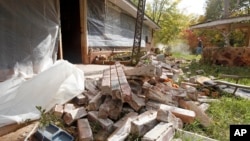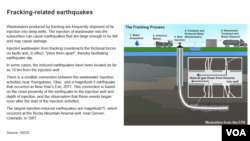A series of new studies by U.S. seismological experts is drawing a closer link between drilling for oil and gas and the disturbing rise in the number of earthquakes in areas not usually prone to seismic activity.
It is by no means breaking news that certain aspects of oil and gas drilling can lead to small earthquakes. But the problem is taking on a new urgency as the U.S. has rapidly expanded oil and gas production in recent years.
The main culprit is the increased use of a controversial drilling technique known as hydraulic fracturing, or fracking. The process involves pumping high-pressure water, sand and chemicals into rock formations deep underground.
Fracking explained
Fracturing the rock releases oil and gas trapped inside. It also creates a massive amount of wastewater. The problem is what to do with that water, says Roger Musson of the British Geological Survey.
"If you inject wastewater into the ground to dispose of it, which is what is being done, then that is what really does trigger earthquakes in the affected area," Musson told VOA by telephone.
It does this by loosening faults, or divisions in the rocks that make up Earth's crust. "Below the water table, there is water in the rocks. And if you change the pressure in that water, then it has the effect of lubricating the faults," he says.
Scientists decades ago reached a consensus that such activities cause earthquakes, says Musson. But the problem is becoming more critical, especially in the U.S., which has seen a fracking boom in the last several years.
Concern over man-made earthquakes
Several recent reports by seismological authorities are also expressing alarm about the increase in man-made earthquakes.
A study released Thursday by the U.S. Geological Survey examined 17 areas within eight states in the central and eastern parts of the U.S. that are newly designated as being vulnerable to earthquakes. Traditionally, quakes have occurred most frequently on the U.S. west coast.
All of the newly earthquake-prone areas are located "near deep fluid injection wells or other industrial activities capable of inducing earthquakes," according to the USGS report.
The most dramatic rise has occurred in the central state of Oklahoma. Before 2008, Oklahoma saw just one or two quakes per year of greater than 3.0-magnitude. It now sees one or two such quakes per day.
In its own report released earlier this week, the state of Oklahoma acknowledged for the first time that it is "very likely" the recent rise in earthquakes was caused by the disposal of oil and gas drilling wastewater.
Most of the allegedly manmade earthquakes have been relatively small and have done little damage. But experts warn there is no guarantee the seismic activity will not increase the chance for much larger temblors.
"This is being debated very urgently by seismologists," says Musson. Currently, scientists believe that wastewater injection can produce earthquakes in the magnitude 4 or 5 range. "But what the upper limit is is really very difficult to judge," he says.
Fracking has also been criticized by environmental rights activists because they say it pollutes groundwater and leaks harmful fumes into the atmosphere.
Supporters of fracking say the innovative drilling process has helped expand the U.S. economy and has reduced American dependence on foreign oil. They say the reports linking earthquakes to drilling activity are exaggerated.









